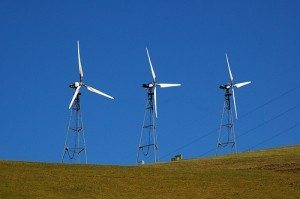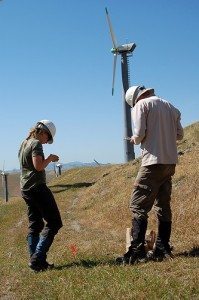Good news for birds at the Altamont wind farm
By Mike Lynes
Our years of advocacy on behalf of raptors at the Altamont Pass wind farm are paying off — with a dramatic reduction in bird mortality there.
Deaths of four key raptor species from Altamont wind turbines dropped by an estimated 50 percent between 2005 and 2010, according to the independent scientific review committee charged with monitoring bird mortality there.
The estimated number of Golden Eagles killed by turbines each year fell from 58 to 33, Burrowing Owls from 543 to 233, American Kestrels from 415 to 268, and Red-tailed Hawks from 196 to 85, according to a report accepted last month by the Scientific Review Committee of the Alameda County Altamont Pass Wind Resource Area (APWRA).
These figures are rough estimates: It’s exceedingly difficult to track exact numbers of bird deaths on the sprawling Altamont Pass. And while the data indicate a decline in risks to birds, we know bird injuries and deaths are likely to always result from wind turbine operations.
But the findings are still very good news. They show that with careful siting and design, it’s possible to significantly reduce the risk to birds from wind turbines.

The results also show the positive impact that Audubon activists can have in speaking up and pressuring wind companies to protect birds.
The roots of this good-news story go back more than a decade, to when we at Golden Gate Bird Alliance joined other Bay Area chapters including Santa Clara Valley, Ohlone, Marin and Mt. Diablo Audubon to advocate for birds and other wildlife at the Altamont Pass. (Other conservation groups such as the Center for Biological Diversity have also stood up for birds at Altamont.)
The oldest wind farm in the country, Altamont had about 5,000 turbines in the area bordering Alameda and Contra Costa counties. Researchers estimated that thousands of birds – some migrants, some year-round residents – were dying from collisions with wind towers and blades.

In 2004, we and our partners sued Alameda County for reissuing wind turbine permits in the APWRA without conducting any environmental review. The settlement of our suit required a 50 percent reduction in bird mortality by 2009, removal of certain high-risk turbines, and development of a comprehensive conservation plan.
In 2010, when it became clear that the 50 percent reduction had not been reached, we pursued further negotiations with NextEra Inc., the largest wind operator at APRWA. NextEra agreed to replace its old turbine fleet with new turbines that we believe are safer for birds, and to provide $2.5 million for habitat conservation and research to reduce bird mortality in the Altamont Pass.

Since then, NextEra has replaced about 1/3 of its old turbines and is moving ahead with plans to replace the rest of its fleet. The newer turbines are much larger but fewer in number, leading to a net decrease of 338 turbines in just the first phase alone.
Before any of the new turbines go in the ground, biologists and engineers work to site them in areas that will decrease collision risks for birds. For example, new turbines are not placed in low saddles or at the edge of ridges, where raptors often prefer to fly. The new turbines also have solid tube bodies rather than the latticed towers that served as attractive but perilous perches for some raptors.
These changes are just a starting point. NextEra still needs to switch over the remaining two-thirds of its turbines. The other wind operators at Altamont have not yet started to switch over to new turbines.
And even with the changeover (or “repowering,” as it is called), wildlife remains at risk. We need to continue monitoring Altamont’s bird and bat populations, and pressing for better ways to safeguard them.
We at Golden Gate Bird Alliance are encouraged by the Scientific Review Committee’s findings that bird deaths have decreased. At the same time, we plan to keep dogging this issue – monitoring, negotiating, testifying and (if necessary) litigating to make sure that this progress continues.
We couldn’t do this without your support! If you’ve been a member or donor to Golden Gate Bird Alliance over the years, take a moment to pat yourself on the back. Your commitment and generosity has made a genuine difference for eagles, owls and other birds at Altamont Pass.
And if this success becomes a model for the wind industry, you will have made a difference for birds in wind power areas around the world.
******************

A copy of the 2005-2010 Monitoring Report is available at http://altamontsrc.org/alt_doc/m87_draft_2010_2011_bird_year_monitoring_report.pdf. (2010 is the most recent year for which data have been analyzed. The next Monitoring Report with more recent mortality data is expected to be available by March 2013.)
Or read about the report in the San Francisco Chronicle.
********************************
Want to help Golden Gate Bird Alliance continue to advocate on behalf of wildlife at Altamont? Click here to support us with a tax-deductible donation.
